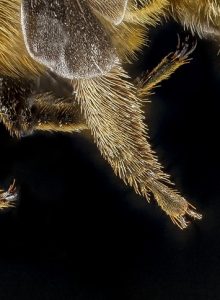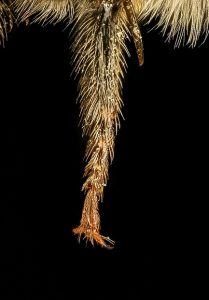Functions
Get, Store or Distribute Resources – Expel – Solids
The last large segment on the middle leg of the bee is known as the midleg basitarsus, seen above in Halictus rubicundus from the University of Calgary Invertebrate Collection. The brush can be used for grooming. The brush cleans off the forelegs as the bee flexes, pulling the foreleg between the basitarsus and the femur to trap pollen and dirt.1
The hairs making up the brush can be different lengths, straight, bent or even hooked. Notice the differences in the brushes of the bees below:




From left to right: Megachile sculpturalis, Melissodes apicata, Megachile petulans, and Megachile fortis. Each photograph from the USGS Bee Inventory and Monitoring Lab.
Some of the stunning images on this page are courtesy of Sam Droege and the USGS Bee Inventory and Monitoring Lab, which develops identification tools and surveys for native bees.
This page was created by Holly Kerstiens in collaboration with Dr. Mindi Summers, Dr. Marjan Eggermont, Dr. Jess Vickruck, Lincoln Best and Dr. Alex Ralevski as part of an independent studies project in winter 2019. This information is also available as a collection on AskNature.org.
Sources
1 The Bees of the World
Hopkins Fulfillment Service. 2007.
Michener, C.D.
